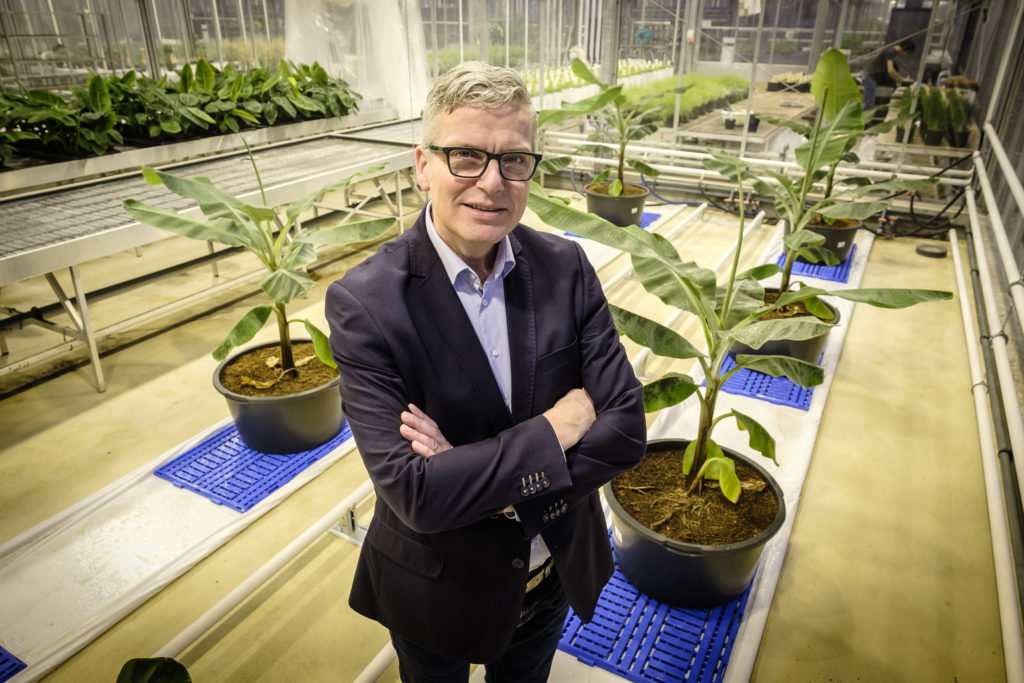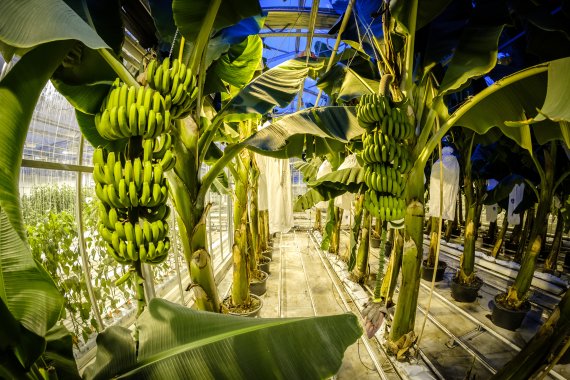Photo’s Guy Ackermans
A few days before the official first harvest, special professor of Tropical Phytopathology Gert Kema looked a bit doubtful about the proposed name Nederbanaan. It doesn’t work outside the country. ‘I would think more in terms of something beginning with ‘Dutch’. That often goes down well abroad.’ But at the presentation for the Dutch press two days later, it is clear that Nederbanaan won the day. The first banana to be grown on substrate.
Anniversary stunt
‘The idea of growing bananas in a greenhouse came from a wish to do something special to mark the WUR centenary,’ explains Kema. ‘When we started working on bananas, everyone laughed at us. But now it is Wageningen’s pet crop.’
Kema has been doing research on bananas for years. He has made it his mission to make the banana more sustainable and to develop varieties that are resistant to the feared Panama disease. To this end, banana plants have been grown in the greenhouses on campus for years. What is new, however, is that Kema and his colleagues have now allowed the plants to grow to maturity and bear fruit. ‘We have never done that before. The idea was to harvest the first bananas from the greenhouse towards Christmas. That is the stunt, the fun part of the project.’
These anniversary bananas are a nice gimmick, but much more important is the serious research objective Kema attaches to the greenhouse banana. These banana plants do not grow in normal soil but in different substrates above the ground. An idea as brilliant as it is simple. It works like this. Panama disease, which threatens bananas worldwide, is caused by soil fungi of the Fusarium genus. The fungi penetrate the plant via its roots and then do their destructive work. Well, if the soil is the problem, keep the plant above the ground, Kema reasons. Go bananas: think out of the box, and keep the fungi out.

Gert Kema
Roof-high
Six rows of nine banana plants have been growing in the Radix greenhouses since the beginning of this year. Some of them stand in plastic basins in coconut fibre, and others on long 12-litre plastic sacks of rockwool. No soil is involved at all. The plants are drip-fed through small pipes. They are quite a sight: cuttings barely 10 centimetres high have grown within a year into giant roof-high plants. The greenhouse is literally overgrown with banana plants. That is lesson number one, says Harold Meijer, Kema’s ‘right-hand and left-hand man’ in the greenhouse.
‘As the experiment progresses, you run into all kinds of problems,’ he continues. ‘The roof is 6.5 metres high, which turns out to be too low. The plants are also close together and are getting in each other’s way. Some of the leaves are three metres long. There is no room for them like this, so you have to train them. And there are too many leaves, anyway. In the field, banana plants only have six or seven leaves, while ours have eight to ten. That’s because there are no diseases here. In the next project we must plant them further apart so individual plants get more light and air.’
No pesticides
Growing bananas on substrate has several obvious advantages, the main one being less disease pressure. This significantly reduces the need for pesticides. In the Radix greenhouses, no pesticides are being used at all. Kema points out the efficient use of nutrients too. ‘In the field, 30 per cent of the nutrients are washed away. None here. With substrate you can also time precisely when you want to put your bananas on the market. That is a big advantage. Currently most bananas are supplied during our summer months. But that is precisely when demand is lowest, because so much fruit comes onto the market then.’ One consequence of substrate cultivation, according to Kema, is that it is an annual crop. ‘A banana plant grows for about 15 years in the field, with a new plant growing out of the old one every year. That’s not possible on substrate.’
The first Dutch bananas are a great success, says Kema. The harvest, about 800 bananas on six ripe bunches, are now ripening in Chiquita’s ripening facility in Gorinchem. The bananas will then find their way via the regional cooperative Boerenhart to restaurants and hospitals in the Gelderland Valley.
Outdoor substrate cultivation
There will almost certainly be more Dutch bananas to come. ‘The next step in the Netherlands is to further diversify the cultivation in a greenhouse or building,’ says Kema. Not with the aim of squeezing the standard banana out of the market. You need a lot of space and heat to grow bananas. But he does see a niche market for banana varieties that are not currently for sale in the Netherlands.
The real focus on the project is elsewhere, though: on countries plagued by Panama disease. Kema: ‘I want to do this trial outdoors in the Philippines. A oneyear experiment with 1000 plastic pots somewhere like a big carpark. Put a fence around them and you’re done. That’s all that’s needed. We are going to discuss this in the Philippines.’
Clever tricks
The Nederbanaan has little to do with Kema’s genetics-based quest for a resistant banana. A new and practical line, you could call it. ‘In phytopathology it’s important to contribute to solving practical problems. This is about the agendas of farmers and companies. That sometimes leads to long-term and fundamental research, and sometimes to clever tricks. Science for Impact, as the WUR slogan goes: that’s what it’s all about in the end. And this might well be a very good example of that.’

